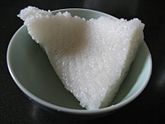This is an old revision of this page, as edited by Discospinster (talk | contribs) at 00:52, 9 December 2013 (Reverted edits by 북한 시즌1 (talk) to last version by Discospinster). The present address (URL) is a permanent link to this revision, which may differ significantly from the current revision.
Revision as of 00:52, 9 December 2013 by Discospinster (talk | contribs) (Reverted edits by 북한 시즌1 (talk) to last version by Discospinster)(diff) ← Previous revision | Latest revision (diff) | Newer revision → (diff)This article has multiple issues. Please help improve it or discuss these issues on the talk page. (Learn how and when to remove these messages)
|

Steamed rice refers to rice that has been cooked either by steaming or boiling.
It is a staple in Korea, China, Japan, Malaysia, Bangladesh, India, Indonesia, Pakistan, Vietnam, Thailand, Myanmar, Philippines, numerous other Latin American and Asian countries. It is also used as a main ingredient in many dishes.
Preparation
Further information: Rice cooker § Traditional rice cooking methods and utensils| Nutritional value per 100 g (3.5 oz) | |||||||||||||||||||||||||||||||||||||||||
|---|---|---|---|---|---|---|---|---|---|---|---|---|---|---|---|---|---|---|---|---|---|---|---|---|---|---|---|---|---|---|---|---|---|---|---|---|---|---|---|---|---|
| Energy | 544 kJ (130 kcal) | ||||||||||||||||||||||||||||||||||||||||
| Carbohydrates | 29 g | ||||||||||||||||||||||||||||||||||||||||
| Sugars | 0 g | ||||||||||||||||||||||||||||||||||||||||
| Dietary fiber | 0 g | ||||||||||||||||||||||||||||||||||||||||
| Fat | 0 g | ||||||||||||||||||||||||||||||||||||||||
| Protein | 2.4 g | ||||||||||||||||||||||||||||||||||||||||
| |||||||||||||||||||||||||||||||||||||||||
| Other constituents | Quantity | ||||||||||||||||||||||||||||||||||||||||
| Water | 68.5 g | ||||||||||||||||||||||||||||||||||||||||
| Percentages estimated using US recommendations for adults, except for potassium, which is estimated based on expert recommendation from the National Academies. | |||||||||||||||||||||||||||||||||||||||||
Steamed rice is traditionally prepared in one of two ways. Actual steaming is done by placing a bowl or pot containing dry rice, along with some water that will be absorbed, into a food steamer, and cooking it until done. Steamed rice is normally cooked by adding dry rice and a small amount of salt to water and boiling it in a covered pot. Today, most rice is prepared in electric rice cookers, that work the same way. During cooking, the rice absorbs the water, increasing in volume and mass. The rice is considered cooked when it has absorbed all the water.
Use in dishes
In China, steamed rice is most commonly served in individual bowls, with each diner receiving one. Food from communal dishes is placed upon the rice, and is then eaten.
Steamed or boiled rice is used as an ingredient in many dishes. In China, leftover steamed rice is used to make porridge eaten the following morning. In Indonesia, leftover steamed rice is used to make nasi goreng for breakfast in the morning. Some other dishes include:
- Bamboo rice, a Chinese dish where rice is steamed inside a segment of bamboo, a Cambodian version is called Kralan.
- Dal bhat, a traditional India and Nepali staple dish.
- Fried rice, an Indonesian version is called nasi goreng.
- Nasi campur, an Indonesian 'mixed rice', surrounded by assorted Indonesian dishes, Balinese version is called nasi Bali.
- Nasi kuning, an Indonesian 'yellow rice', a turmeric colored steamed rice.
- Nasi lemak, a Malay steamed rice cooked in coconut milk, Indonesian version is called nasi uduk.
- Onigiri, a Japanese rice ball, similar Indonesian version is called lemper.
- Puto, a Philippine steamed rice cake.
- Red beans and rice
- Rice and beans
- Rijsttafel, a Dutch 'rice table', derived from Indonesian cuisine during colonial times.
- Sushi, a Japanese vinegared rice with raw fish or other ingredients.
- Tteok, a type of Korean rice cake
- Tumpeng, a Javanese cone shaped steamed rice surrounded by assorted dishes.
- Zongzi, a traditional Chinese dish using glutinous rice steamed inside a leaf or bamboo.
Use in beverages
- Makgeolli (막걸리), a Korean alcoholic rice wine.
- Sake (酒), a Japanese alcoholic beverage.
- Yuk Bing Siu Zau (玉冰燒酒), a Cantonese alcoholic rice wine.
Varieties
Most common is plain, steamed white rice, however a number of varieties and are served, many with specific cooking methods. Some varieties include:
- Thai steamed rice
- Sticky rice
- Sushi rice (cooked with the addition of Japanese rice vinegar and sugar)
- Basmati rice
- Original Steamed Fried Rice – Freshly cooked or aged rice stir-fried with garlic, then topped with a thick savory sauce laden with either beef, chicken or pork, shrimp and green peas, seasoned with Cebu's version of Patis and Soy Sauce. This is typical in most Dim Sum presentations throughout the Philippines. It was believed to be brought by Chinese immigrants from outside the country during the early 1900s and was considered to start in Cebu City. It is uncommon to the traditional Dim Sum that originated in China.
Gallery
See also
References
- Shiok - Chef's Notes: How to make perfect steamed rice
- United States Food and Drug Administration (2024). "Daily Value on the Nutrition and Supplement Facts Labels". FDA. Archived from the original on 2024-03-27. Retrieved 2024-03-28.
- National Academies of Sciences, Engineering, and Medicine; Health and Medicine Division; Food and Nutrition Board; Committee to Review the Dietary Reference Intakes for Sodium and Potassium (2019). "Chapter 4: Potassium: Dietary Reference Intakes for Adequacy". In Oria, Maria; Harrison, Meghan; Stallings, Virginia A. (eds.). Dietary Reference Intakes for Sodium and Potassium. The National Academies Collection: Reports funded by National Institutes of Health. Washington, DC: National Academies Press (US). pp. 120–121. doi:10.17226/25353. ISBN 978-0-309-48834-1. PMID 30844154. Retrieved 2024-12-05.
- http://www.certifiedfoodies.com/2010/09/cebu-style-steamed-rice-in-manila-recipe/
External links
| Glutinous rice dishes | |
|---|---|
| List of rice dishes | |
|




